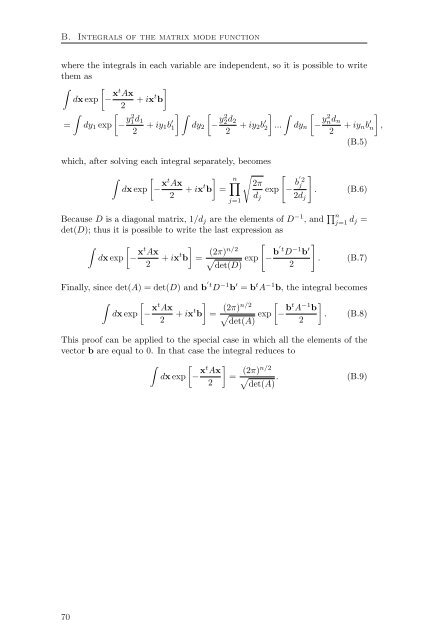Spatial Characterization Of Two-Photon States - GAP-Optique
Spatial Characterization Of Two-Photon States - GAP-Optique
Spatial Characterization Of Two-Photon States - GAP-Optique
You also want an ePaper? Increase the reach of your titles
YUMPU automatically turns print PDFs into web optimized ePapers that Google loves.
B. Integrals of the matrix mode function<br />
where the integrals in each variable are independent, so it is possible to write<br />
them as<br />
<br />
dx exp − xtAx <br />
=<br />
2 + ixt <br />
b<br />
<br />
dy1 exp − y2 1d1<br />
2 + iy1b ′ 1<br />
<br />
dy2<br />
<br />
− y2 2d2<br />
2 + iy2b ′ <br />
2 ...<br />
which, after solving each integral separately, becomes<br />
<br />
<br />
dx exp − xtAx 2 + ixt <br />
b =<br />
n<br />
j=1<br />
<br />
2π<br />
dj<br />
exp<br />
<br />
dyn<br />
− b′ 2<br />
j<br />
2dj<br />
<br />
− y2 ndn<br />
2 + iynb ′ <br />
n ,<br />
(B.5)<br />
<br />
. (B.6)<br />
Because D is a diagonal matrix, 1/dj are the elements of D−1 , and n j=1 dj =<br />
det(D); thus it is possible to write the last expression as<br />
<br />
<br />
dx exp − xtAx 2 + ixt <br />
b = (2π)n/2<br />
exp<br />
det(D)<br />
<br />
− b′ t D −1 b ′<br />
2<br />
<br />
. (B.7)<br />
Finally, since det(A) = det(D) and b ′ t D −1 b ′ = b t A −1 b, the integral becomes<br />
<br />
<br />
dx exp − xtAx 2 + ixt <br />
b = (2π)n/2<br />
<br />
exp −<br />
det(A) btA−1 <br />
b<br />
. (B.8)<br />
2<br />
This proof can be applied to the special case in which all the elements of the<br />
vector b are equal to 0. In that case the integral reduces to<br />
<br />
dx exp − xt <br />
Ax<br />
=<br />
2<br />
(2π)n/2<br />
. (B.9)<br />
det(A)<br />
70



